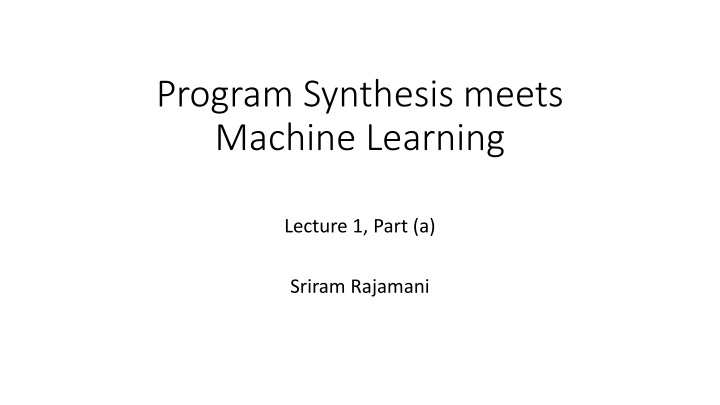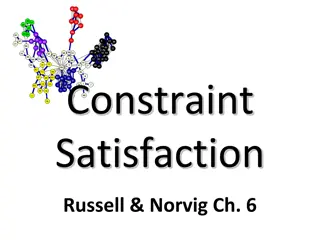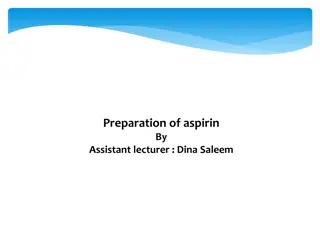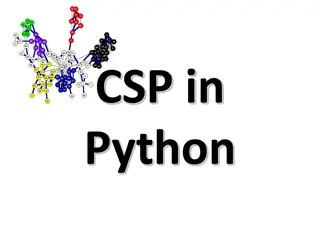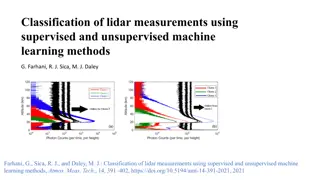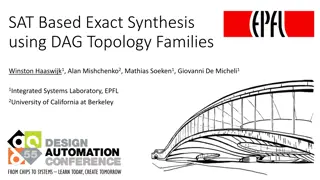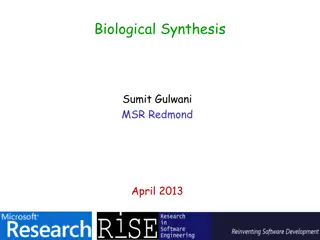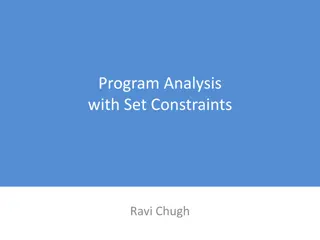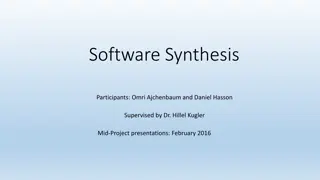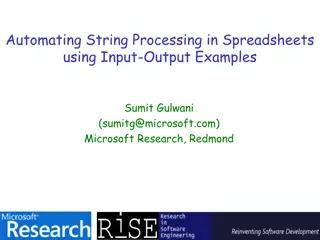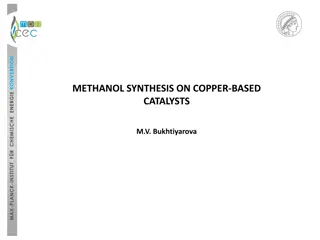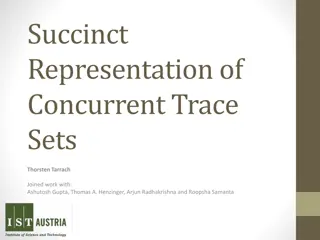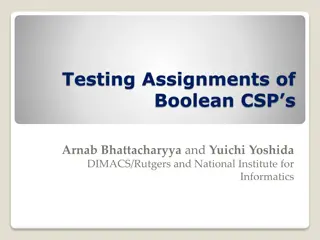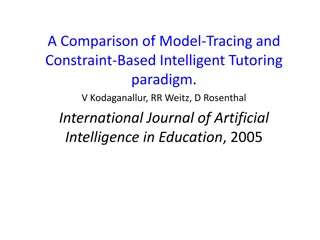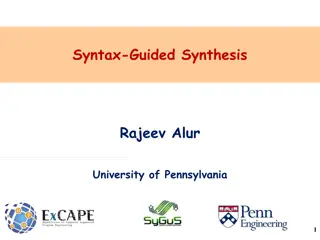Program Synthesis Meets Machine Learning: Lecture on Constraint-Based Methods
In this lecture series, delve into the fusion of program synthesis and machine learning with a focus on constraint-based methods. Explore theoretical frameworks, implementation strategies, and modern practices shaping this innovative field. From foundational principles to advanced techniques, unravel the symbiosis between logical relations, input-output synthesis, and function space constraints. Join leading experts as they navigate through synthesis techniques, research presentations, and project milestones to offer a comprehensive overview of this dynamic domain.
Download Presentation

Please find below an Image/Link to download the presentation.
The content on the website is provided AS IS for your information and personal use only. It may not be sold, licensed, or shared on other websites without obtaining consent from the author.If you encounter any issues during the download, it is possible that the publisher has removed the file from their server.
You are allowed to download the files provided on this website for personal or commercial use, subject to the condition that they are used lawfully. All files are the property of their respective owners.
The content on the website is provided AS IS for your information and personal use only. It may not be sold, licensed, or shared on other websites without obtaining consent from the author.
E N D
Presentation Transcript
Program Synthesis meets Machine Learning Lecture 1, Part (a) Sriram Rajamani
Course logistics 2 lectures per week: Monday & Wednesday 3:30-5:00PM Course instructors: Chiranjib Bhattacharya, Deepak D Souza, Sriram Rajamani Teaching Assistants: P. Habeeb and Rekha Pai Grading Assignments + Presentation (30%) Mid-semester exam (30%) Project and final (40%)
Rough Timeline January Mid February. Foundations (~6-7 weeks) Course overview (Sriram) Constraint based methods for synthesis(Sriram) Enumerative techniques for synthesis (Deepak) Black box learning (Deepak) Machine learning background for synthesis (Chiranjib) (includes graded assignments) Mid-late February: Mid-semester exam Mid-February Late March: Research paper presentations by students (~5 weeks) March April 15: Course project, with final project presentations in April
What if we can constrain the space of functions ? ? Specification: What Logical relation ?( ?,?) among input ? and output ? Synthesizer Constructive proof of ?. ??(?,?(?)) Implementation: How Function ?(?) such that ?.?(?,?(?)) Solutions provided by Buchi and Landweber (1969) and M O Rabin (1972), first based on specifications in Monadic Second Order Logics (non elementary complexity), then temporal logics (PSPACE or EXP Time) etc. Largely of theoretical interest
Modern synthesis Constrain the space of functions using a template or a sketch [Bodik-Lezama 2008] Flashfill and PROSE: Specify using input-output examples, and search for solutions using clever enumeration over all programs in a DSL [Gulwani 2011, Gulwani- Polozov 2015]
Examples Desired program P: bit-vector transformation that resets rightmost substring of contiguous 1 s to 0 s: 1. P should be constructed from standard bit- vector operations |, &, ~, +, -, <<, >>, 0, 1, 2. P specified using input-output examples 00101 00100 01010 01000 10110 10000 if if (input[1] == ) then Concat(input[2], Const( , ), input[0], Const( ), let let v = input[1] in in Substring(v, AbsPos(v, 0), RegexPos Const( . )) then Concat(input[2], Const( , ), Desired solution: x & ( 1 + (x | (x-1 )))
Supervised learning has similar goals, but different perspective Specifications: Loss functions DSL : Model schema with parameters to learn Search technique: Continuous optimization methods (e.g. Gradient descent)
Machine Learning Program Synthesis Specification: Logical formulas, small number of homogeneous examples, Domain Specific Language (DSLs) Search Algorithm: Combinatorial search Output: Program which satisfies specification Characteristics: Synthesized program is interpretable, expressiveness configurable using DSL Has difficulty handling noisy data Specification: Large amount of training data, loss function, model schema Search Algorithm: Optimization (e.g., gradient descent) Output: Function which minimizes loss Characteristics: Successful ML methods produce functions that are not interpretable Robust to noise, generalization Can we combine the strengths of the two approaches? What problems can we solve by such a combination?
Program Verification {true} max = -MAXINT; i = 0; while (i < N) { if( a[i] > max) max = a[i]; i = i+1; } { 0 ?< ?. ?[?] max} A Hoare triple is a formula of the form {P} Q {R} where P and R are predicates Q is a program statement Meaning: If we start the program at a state satisfying P, and run the statement Q, the statement terminates and results in a state satisfying R To check {P} Q {R} Check validity of the formula P WP(Q, R) using a theorem prover
Synthesis is the inverse of verification Verification: Given pre-condition P, post-condition R and program Q Check {P} Q {R} Synthesis: Given pre-condition P, post-condition R, synthesize a program program Q such that {P} Q {R} Approach: Check validity of the formula P WP(Q, R) using a theorem prover Sketching: Given pre-condition P, post-condition R, a partial program Q with holes , synthesize a completion C of holes such that {P} Q[C] {R}
Tutorial introduction to synthesis using Sketch Sketch is a constraint-based synthesis system developed by Armando Solar Lezama Download from: https://people.csail.mit.edu/asolar/
Synthesizing a constant (1) harness void doublesketch(int x) void doublesketch (int x)/*double.sk:1*/ { assert ((x * 2) == (x + x)); //Assert at double.sk:3 (2) } /*double.sk:1*/ { int t = x * ??; assert t == x + x; }
Synthesizing a constant (2) void doublesketch (bit[8] x)/*double-ls.sk:1*/ { assert ((x << 1) == (x + x)); //Assert at double-ls.sk:3 (2) } /*double-ls.sk:1*/ harness void doublesketch (bit[8] x){ bit[8] t = (x << ?? ); assert t == x + x; }
Least zero-bit (~(x + 0) & (x + 1)) Problem: Detect the least significant bit in a word with 0 value, and mark that bit as 1 in the output, and reset all other bits to 0. int W = 32; bit[W] least_sig0(bit[W] x){ return (~(x + ??) & (x + ??)); } Do this with a program of the form: ~(x + K1) & (x + K2) bit[W] simple_least_sig0(bit[W] x){ bit[W] ret = 0; for (int i = 0; i < W; i++){ if (!x[i]) { ret[i] = 1; return ret;} } return ret; } Examples: 00010111 00001000 00010110 00000001 11111111 00000000 harness void main(bit[W] x){ assert least_sig0(x) == simple_least_sig0(x); }
(~(x + 0xFFFFFFFF) & (x +0)) Least one-bit Problem: Detect the least significant bit in a word with 1 value, and mark that bit as 1 in the output, and reset all other bits to 0. int W = 32; bit[W] least_sig0(bit[W] x){ return (~(x + ??) & (x + ??)); } Do this with a program of the form: ~(x + K1) & (x + K2) bit[W] simple_least_sig0(bit[W] x){ bit[W] ret = 0; for (int i = 0; i < W; i++){ if (x[i]) { ret[i] = 1; return ret;} } return ret; } Examples: 00010111 00000001 00010110 00000010 00000000 00000000 harness void main(bit[W] x){ assert least_sig0(x) == simple_least_sig0(x); }
Swapping x = x^y y = x^y x = x^y Problem: Swap two inputs with a sequence of assignments using exor and no temporary variables. int W = 32; void swap(ref bit[W] x, ref bit[W] y){ if(??){ x = x ^ y; }else{ y = x ^ y; } if(??){ x = x ^ y; }else{ y = x ^ y; } That is, using a program of the form x = x ^ y y = x ^ y .. With 3 assignment statements if(??){ x = x ^ y; }else{ y = x ^ y; } } harness void main(bit[W] x, bit[W] y){ bit[W] xold = x, yold = y; swap(x,y); assert y == xold && x == yold; }
Homework (1) Desired program P: bit-vector transformation that resets rightmost 1 to 0: Homework: Synthesize a solution to this problem using Sketch 1. P should be constructed from standard bit- vector operations |, &, ~, +, -, <<, >>, 0, 1, 2. P specified using input-output examples 00101 00100 01010 01000 10110 10100
Homework (2) Desired program P: bit-vector transformation that resets rightmost substring of contiguous 1 s to 0 s: Homework: Synthesize a solution to this problem using Sketch 1. P should be constructed from standard bit- vector operations |, &, ~, +, -, <<, >>, 0, 1, 2. P specified using input-output examples 00101 00100 01010 01000 10110 10000 Desired solution: x & ( 1 + (x | (x-1 )))
How does Sketch work? Search through all possible ways to fill the hole ?? such that the specification is satisfied: harness void doublesketch(int x) { Find c such that: int t = x * ??; ?. ( ? ? = ? + ?) assert t == x + x; } Equivalently: ?. ?. ( ? ? = ? + ?) In general, every sketching problem can be converted to solving a formula of the form: ?1?2 ?1?2. ?(?1,?2,..,?1,?2 )
Recipe for Constraint based synthesis 1. Convert the synthesis problem ? to a formula ? 2. Solve ? using a constraint solver 3. Map solution from constraint solver back to the synthesis problem ? Types of constraint solvers: SAT Solvers (Boolean Satisfiability) SMT Solvers (Satisfiability Modulo Theories) Solvers for Quantified Formulas (QBF or CEGIS solvers)
